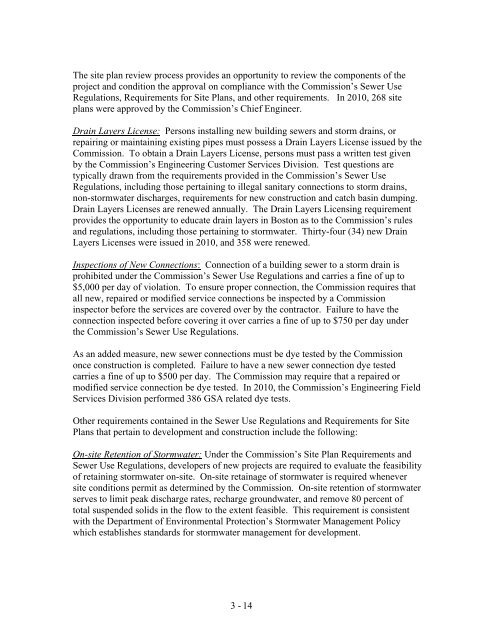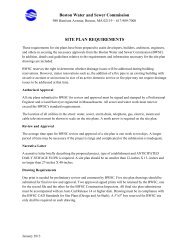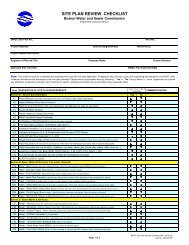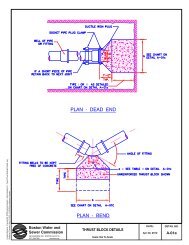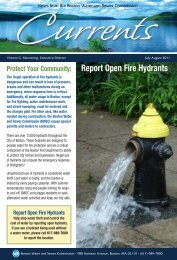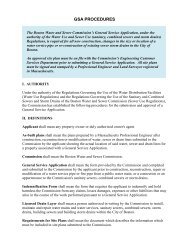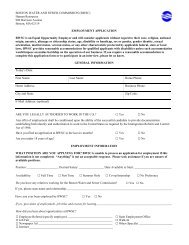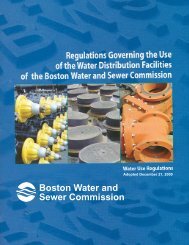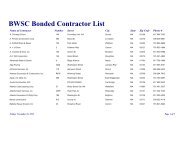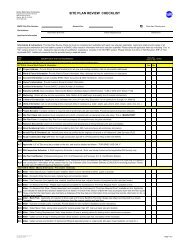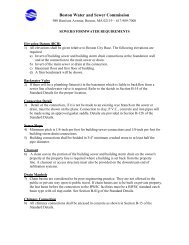2010 Stormwater Management Report (PDF) - US Environmental ...
2010 Stormwater Management Report (PDF) - US Environmental ...
2010 Stormwater Management Report (PDF) - US Environmental ...
You also want an ePaper? Increase the reach of your titles
YUMPU automatically turns print PDFs into web optimized ePapers that Google loves.
The site plan review process provides an opportunity to review the components of the<br />
project and condition the approval on compliance with the Commission’s Sewer Use<br />
Regulations, Requirements for Site Plans, and other requirements. In <strong>2010</strong>, 268 site<br />
plans were approved by the Commission’s Chief Engineer.<br />
Drain Layers License: Persons installing new building sewers and storm drains, or<br />
repairing or maintaining existing pipes must possess a Drain Layers License issued by the<br />
Commission. To obtain a Drain Layers License, persons must pass a written test given<br />
by the Commission’s Engineering Customer Services Division. Test questions are<br />
typically drawn from the requirements provided in the Commission’s Sewer Use<br />
Regulations, including those pertaining to illegal sanitary connections to storm drains,<br />
non-stormwater discharges, requirements for new construction and catch basin dumping.<br />
Drain Layers Licenses are renewed annually. The Drain Layers Licensing requirement<br />
provides the opportunity to educate drain layers in Boston as to the Commission’s rules<br />
and regulations, including those pertaining to stormwater. Thirty-four (34) new Drain<br />
Layers Licenses were issued in <strong>2010</strong>, and 358 were renewed.<br />
Inspections of New Connections: Connection of a building sewer to a storm drain is<br />
prohibited under the Commission’s Sewer Use Regulations and carries a fine of up to<br />
$5,000 per day of violation. To ensure proper connection, the Commission requires that<br />
all new, repaired or modified service connections be inspected by a Commission<br />
inspector before the services are covered over by the contractor. Failure to have the<br />
connection inspected before covering it over carries a fine of up to $750 per day under<br />
the Commission’s Sewer Use Regulations.<br />
As an added measure, new sewer connections must be dye tested by the Commission<br />
once construction is completed. Failure to have a new sewer connection dye tested<br />
carries a fine of up to $500 per day. The Commission may require that a repaired or<br />
modified service connection be dye tested. In <strong>2010</strong>, the Commission’s Engineering Field<br />
Services Division performed 386 GSA related dye tests.<br />
Other requirements contained in the Sewer Use Regulations and Requirements for Site<br />
Plans that pertain to development and construction include the following:<br />
On-site Retention of <strong>Stormwater</strong>: Under the Commission’s Site Plan Requirements and<br />
Sewer Use Regulations, developers of new projects are required to evaluate the feasibility<br />
of retaining stormwater on-site. On-site retainage of stormwater is required whenever<br />
site conditions permit as determined by the Commission. On-site retention of stormwater<br />
serves to limit peak discharge rates, recharge groundwater, and remove 80 percent of<br />
total suspended solids in the flow to the extent feasible. This requirement is consistent<br />
with the Department of <strong>Environmental</strong> Protection’s <strong>Stormwater</strong> <strong>Management</strong> Policy<br />
which establishes standards for stormwater management for development.<br />
3 - 14


